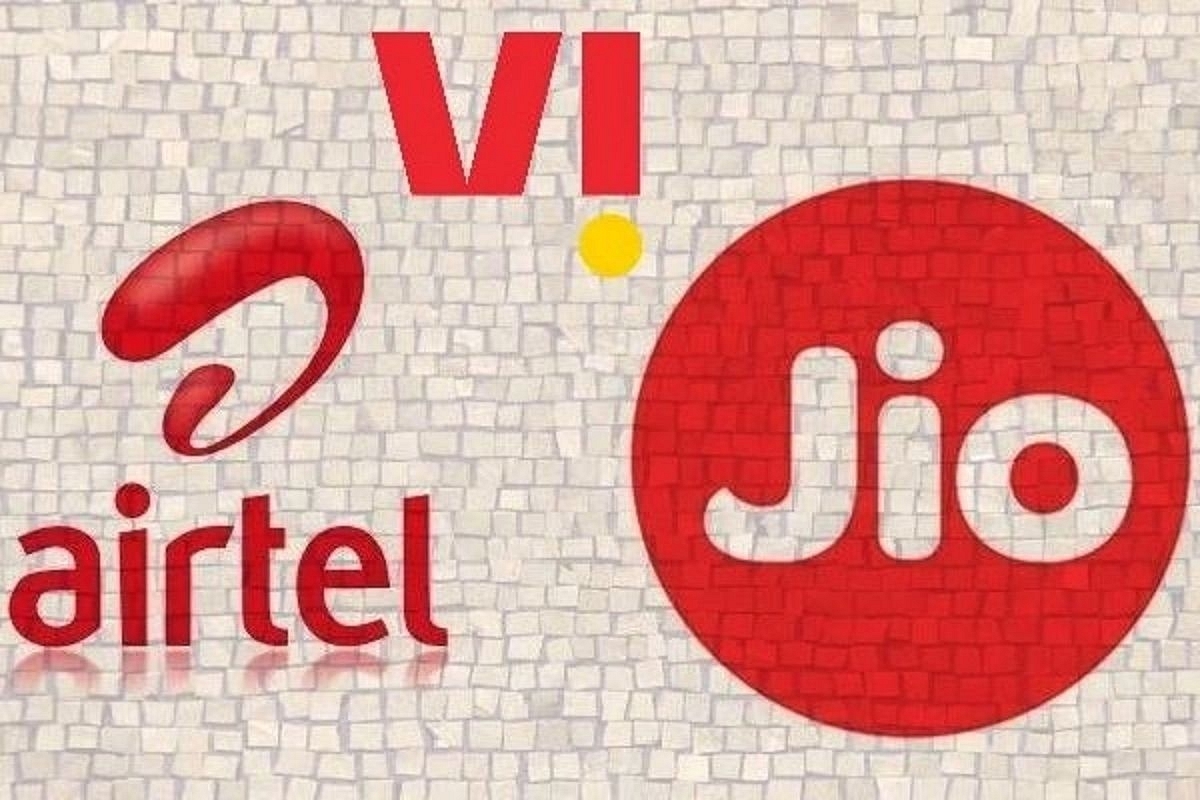News Brief
Telcos Urge For More Than 90 Per Cent Reduction In 5G Spectrum Price
- According to Vodafone Idea's remarks to the TRAI, the reserve price for the 3,300-3,670 MHz band should be decreased by nearly 90 per cent of the previous valuation basis.
- As per Reliance Jio's submission, the reserve price for mid-band spectrum should be reduced by around 95 per cent for a pan-India 100 MHz block.
- Whereas, Bharti Airtel has stated that spectrum prices should not exceed 10 per cent of the pricing indicated earlier in 2018.

Logos of India's telcos - Airtel, Jio and Vodafone Idea
Telecom companies have requested that the reserve price for the 5G spectrum be reduced by more than 90 per cent for the future auction, with no upfront payment and a 5-year embargo. After the moratorium period, the amount of spectrum can be recovered over a period of 24 years, according to reports.
For the pan-Indian spectrum in the mid-band 3,300-3,670, the regulator had previously recommended a price of Rs 492 crore per MHz. However, all the top telcos have argued that this figure was far too costly, implying that 5G services would be unviable.
Later reports highlighted that according to Vodafone Idea's remarks to the Telecom Regulatory Authority of India (TRAI), the reserve price for the 3,300-3,670 MHz band would have to be decreased by nearly 90 per cent of the previous valuation basis, when a reserve price of Rs 492 crore/Mhz for pan-India spectrum was recommended. On a per MHz basis, the pricing for the mmWave band (24.25 GHz to 28.5 GHz) should not be more than 1 per cent of the pricing for 3,300-3,670 MHz.
As per Reliance Jio's submission, the reserve price for mid-band spectrum should be reduced by around 95 per cent for a pan-India 100 MHz block, the reserve price for mmWave bands should be kept at 1/100th of the mid-band, and the reserve price for spectrum in V-band and E-band should be kept at 50 per cent of mmWave, taking into account India's low average revenue per user or ARPU, purchasing power and international benchmarks.
The other big name in the field of telecommunication, Bharti Airtel, has stated that spectrum prices should be modest at best, and should not exceed 10 per cent of the pricing indicated earlier in 2018.
The telecom operators have noted that TRAI’s valuation methodology and assumptions within need to be taken another look given the altered market realities including the health of the industry and revenue-generating ability.
Bharti Airtel said: “Its previous approaches like the indexation of past prices, avoided cost method are not relevant due to the changing dynamics of the 5G era. It is no longer enough to augment additional capacity for the same traffic and avoid the cost.”
Furthermore, worldwide experience suggests that 5G's incremental revenue has been insignificant and that it has been unable to recoup its incremental cost.
In terms of payment arrangements, Bharti Airtel and Vodafone Idea have offered no upfront payment with a six-year moratorium, whereas Reliance Jio has proposed a 10 per cent upfront payment to secure telecom operators' commitment, followed by a five-year payment moratorium.
While Vodafone has proposed 20 annual instalments with interest at the RBI repo rate—a rate at which the central bank lends money to commercial banks in the event of any shortfall of funds and used by monetary authorities to control inflation—after the moratorium period, Jio has proposed 25 instalments with interest at the RBI repo rate after the moratorium period.
Additionally, in the case of Bharti Airtel, after the moratorium, the company wants 24 instalment payments with no interest. In terms of spectrum caps, Airtel has requested that the sub-GHz band's 50 per cent cap be decreased to 35 per cent, while the total cap of 35 per cent needs to be maintained.
Additionally, according to Reliance Jio, the 35 per cent cap is not adequate for promoting competition in an essentially three-player market since it may lead to quasi-administrative allocation in some coveted bands; so, the company believes that it should be 50 per cent.
Support Swarajya's 50 Ground Reports Project & Sponsor A Story
Every general election Swarajya does a 50 ground reports project.
Aimed only at serious readers and those who appreciate the nuances of political undercurrents, the project provides a sense of India's electoral landscape. As you know, these reports are produced after considerable investment of travel, time and effort on the ground.
This time too we've kicked off the project in style and have covered over 30 constituencies already. If you're someone who appreciates such work and have enjoyed our coverage please consider sponsoring a ground report for just Rs 2999 to Rs 19,999 - it goes a long way in helping us produce more quality reportage.
You can also back this project by becoming a subscriber for as little as Rs 999 - so do click on this links and choose a plan that suits you and back us.
Click below to contribute.
Latest